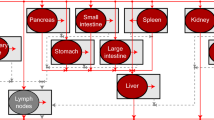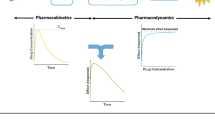Abstract
To systematically assess the characteristics and potential utility of the Guggenheim–Anderson–de Boer (GAB) formulation of the Brunauer–Emmett–Teller (BET) equation from physical chemistry for modeling dose-responses in pharmaceutical applications. The GAB–BET equation was derived using pharmacodynamic first principles to underscore the assumptions involved and the functional characteristics of the equation were investigated. The properties of the GAB–BET equation were compared to the familiar Michaelis–Menten and Hill equations and its utility for pharmacokinetic-pharmacodynamic modeling was assessed by fitting the model equations to four diverse data sets from the literature. The results enabled the salient characteristics of the unconstrained GAB–BET equation and the corresponding GAB–BET equation with finite layers for modeling pharmacodynamic effects to be critically assessed. The GAB–BET approach allows for the accumulation of heterogeneous stacks containing multiple cells or molecules at the target site. The unconstrained GAB–BET equation is capable of describing concentration-dependent dose–response curves that do not exhibit saturation. The GAB–BET equation for finite layers exhibits saturation but increases more slowly than the comparable Michaelis–Menten and Hill equations. The fitting results of the model equations to literature data sets provided support for key aspects of the GAB–BET model. The GAB–BET equation may be a useful method for mechanistic modeling of diverse immune processes and drugs that recruit immune cell activity at the site of action.




Similar content being viewed by others
References
Klinger M, Brandl C, Zugmaier G, Hijazi Y, Bargou RC, Topp MS, Gokbuget N, Neumann S, Goebeler M, Viardot A, Stelljes M, Bruggemann M, Hoelzer D, Degenhard E, Nagorsen D, Baeuerle PA, Wolf A, Kufer P (2012) Immunopharmacologic response of patients with B-lineage acute lymphoblastic leukemia to continuous infusion of T cell-engaging CD19/CD3-bispecific BiTE antibody blinatumomab. Blood 119(26):6226–6233. https://doi.org/10.1182/blood-2012-01-400515
Ali S, Moreau A, Melchiorri D, Camarero J, Josephson F, Olimpier O, Bergh J, Karres D, Tzogani K, Gisselbrecht C, Pignatti F (2020) Blinatumomab for acute lymphoblastic leukemia: the first bispecific T-cell engager antibody to be approved by the EMA for minimal residual disease. Oncologist 25(4):e709–e715. https://doi.org/10.1634/theoncologist.2019-0559
Gonzalez-Exposito R, Semiannikova M, Griffiths B, Khan K, Barber LJ, Woolston A, Spain G, von Loga K, Challoner B, Patel R, Ranes M, Swain A, Thomas J, Bryant A, Saffery C, Fotiadis N, Guettler S, Mansfield D, Melcher A, Powles T, Rao S, Watkins D, Chau I, Matthews N, Wallberg F, Starling N, Cunningham D, Gerlinger M (2019) CEA expression heterogeneity and plasticity confer resistance to the CEA-targeting bispecific immunotherapy antibody cibisatamab (CEA-TCB) in patient-derived colorectal cancer organoids. J Immunother Cancer 7(1):101. https://doi.org/10.1186/s40425-019-0575-3
Brunauer S, Emmett PH, Teller E (1938) Adsorption of gases in multimolecular layers. J Am Chem Soc 60(2):309–319. https://doi.org/10.1021/ja01269a023
Anderson RB (1946) Modifications of the Brunauer, Emmett and Teller equation. J Am Chem Soc 68(4):686–691. https://doi.org/10.1021/ja01208a049
de Boer JH (1953) The dynamical character of adsorption. Clarendon Press, Oxford
Guggenheim EA (1966) Applications of statistical mechanics. Clarendon Press, Oxford
Rouquerol F, Rouquerol J, Sing K (1999) Chapter 4 - Interpretation of physisorption isotherms at the gas–solid interface. In: Rouquerol F, Rouquerol J, Sing K (eds) Adsorption by powders and porous solids. Academic Press, London, pp 93–115
Hill TL (1996) Adsorption from a one-dimensional lattice gas and the Brunauer-Emmett-Teller equation. Proc Natl Acad Sci USA 93(25):14328–14332. https://doi.org/10.1073/pnas.93.25.14328
Ismail M (2019) PinPoint digitizer. https://mhismail.github.io/PinPoint-Landing/
Luconi M, Muratori M, Forti G, Baldi E (1999) Identification and characterization of a novel functional estrogen receptor on human sperm membrane that interferes with progesterone effects. J Clin Endocrinol Metab 84(5):1670–1678. https://doi.org/10.1210/jcem.84.5.5670
D'Argenio DZ, Schlumitzky A, Wang X (2009) ADAPT 5 user’s guide: Pharmacokinetic/pharmacodynamic systems analysis software. Biomedical Simulations Resource. University of Southern California, Los Angeles
Dezorella N, Kay S, Baron S, Shapiro M, Porat Z, Deutsch V, Herishanu Y, Katz BZ (2016) Measurement of lymphocyte aggregation by flow cytometry-physiological implications in chronic lymphocytic leukemia. Cytometry B Clin Cytom 90(3):257–266. https://doi.org/10.1002/cyto.b.21263
Kong HJ, Boontheekul T, Mooney DJ (2006) Quantifying the relation between adhesion ligand-receptor bond formation and cell phenotype. Proc Natl Acad Sci USA 103(49):18534–18539. https://doi.org/10.1073/pnas.0605960103
Kelemen RK, Rajakaruna H, Cockburn IA, Ganusov VV (2019) Clustering of activated CD8 T cells around malaria-infected hepatocytes is rapid and is driven by antigen-specific cells. Front Immunol 10:2153. https://doi.org/10.3389/fimmu.2019.02153
Gregg SJ, Jacobs J (1948) An examination of the adsorption theory of Brunauer, Emmett, and Teller, and Brunauer, Deming, Deming and Teller. Trans Farad Soc 44:574–588. https://doi.org/10.1039/TF9484400574
Blahovec J, Yanniotis S (2008) GAB Generalized equation for sorption phenomena. Food Bioprocess Technol 1(1):82–90. https://doi.org/10.1007/s11947-007-0012-3
Cockburn IA, Amino R, Kelemen RK, Kuo SC, Tse SW, Radtke A, Mac-Daniel L, Ganusov VV, Zavala F, Menard R (2013) In vivo imaging of CD8+ T cell-mediated elimination of malaria liver stages. Proc Natl Acad Sci USA 110(22):9090–9095. https://doi.org/10.1073/pnas.1303858110
Langmuir I (1918) The adsorption of gases on plane surface of glass, mica and platinum. J Am Chem Soc 40(9):1361–1402. https://doi.org/10.1021/ja02242a004
Ebadi A, Soltan Mohammadzadeh JS, Khudiev A (2009) What is the correct form of BET isotherm for modeling liquid phase adsorption? Adsorption 15(1):65–73. https://doi.org/10.1007/s10450-009-9151-3
Gupta KK, Khan MA, Singh SK (2020) Constitutive inflammatory cytokine storm: a major threat to human health. J Interferon Cytokine Res 40(1):19–23. https://doi.org/10.1089/jir.2019.0085
Acknowledgements
We thank JimB, an online contributor at Mathematica Stack Exchange who helped us troubleshoot the maximum likelihood estimation for the probability distribution function of the BET equation.
Funding
Murali Ramanathan received research funding from the National Institutes of Health. He has also received research funding from Otsuka Pharmaceutical Research and Development and the Department of Defense Congressionally-Directed Research Program: Multiple Sclerosis Research Program (MS190096). These are unrelated to the research presented in this report.
Author information
Authors and Affiliations
Contributions
VAN—Data analysis, manuscript preparation. MR—Study concept and design, data analysis, manuscript preparation.
Corresponding author
Additional information
Publisher's Note
Springer Nature remains neutral with regard to jurisdictional claims in published maps and institutional affiliations.
Electronic supplementary material
Below is the link to the electronic supplementary material.
Rights and permissions
About this article
Cite this article
Nguyen, V.A., Ramanathan, M. Application of Brunauer–Emmett–Teller (BET) theory and the Guggenheim–Anderson–de Boer (GAB) equation for concentration-dependent, non-saturable cell–cell interaction dose-responses. J Pharmacokinet Pharmacodyn 47, 561–572 (2020). https://doi.org/10.1007/s10928-020-09708-x
Received:
Accepted:
Published:
Issue Date:
DOI: https://doi.org/10.1007/s10928-020-09708-x




